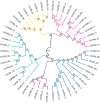A role for the CXCR4-CXCL12 axis in the little skate, Leucoraja erinacea
- PMID: 29641231
- PMCID: PMC6139610
- DOI: 10.1152/ajpregu.00322.2017
A role for the CXCR4-CXCL12 axis in the little skate, Leucoraja erinacea
Abstract
The interaction between C-X-C chemokine receptor type 4 (CXCR4) and its cognate ligand C-X-C motif chemokine ligand 12 (CXCL12) plays a critical role in regulating hematopoietic stem cell activation and subsequent cellular mobilization. Extensive studies of these genes have been conducted in mammals, but much less is known about the expression and function of CXCR4 and CXCL12 in non-mammalian vertebrates. In the present study, we identify simultaneous expression of CXCR4 and CXCL12 orthologs in the epigonal organ (the primary hematopoietic tissue) of the little skate, Leucoraja erinacea. Genetic and phylogenetic analyses were functionally supported by significant mobilization of leukocytes following administration of Plerixafor, a CXCR4 antagonist and clinically important drug. Our results provide evidence that, as in humans, Plerixafor disrupts CXCR4/CXCL12 binding in the little skate, facilitating release of leukocytes into the bloodstream. Our study illustrates the value of the little skate as a model organism, particularly in studies of hematopoiesis and potentially for preclinical research on hematological and vascular disorders.
Keywords: C-X-C chemokine ligand 12; C-X-C chemokine receptor type 4; Plerixafor/AMD3100; elasmobranch; mobilization.
Figures





Similar articles
-
PIM1 inhibition effectively enhances plerixafor-induced HSC mobilization by counteracting CXCR4 upregulation and blocking CXCL12 secretion.Leukemia. 2019 May;33(5):1296-1301. doi: 10.1038/s41375-019-0428-6. Epub 2019 Feb 28. Leukemia. 2019. PMID: 30816332 No abstract available.
-
Effective mobilization of hematopoietic progenitor cells in G-CSF mobilization defective CD26-/- mice through AMD3100-induced disruption of the CXCL12-CXCR4 axis.Exp Hematol. 2011 Mar;39(3):384-90. doi: 10.1016/j.exphem.2010.12.003. Epub 2010 Dec 17. Exp Hematol. 2011. PMID: 21168468 Free PMC article.
-
Dual blockade of CXCL12-CXCR4 and PD-1-PD-L1 pathways prolongs survival of ovarian tumor-bearing mice by prevention of immunosuppression in the tumor microenvironment.FASEB J. 2019 May;33(5):6596-6608. doi: 10.1096/fj.201802067RR. Epub 2019 Feb 25. FASEB J. 2019. PMID: 30802149 Free PMC article.
-
Plerixafor, a CXCR4 antagonist for the mobilization of hematopoietic stem cells.Expert Opin Biol Ther. 2008 Nov;8(11):1797-804. doi: 10.1517/14712598.8.11.1797. Expert Opin Biol Ther. 2008. PMID: 18847313 Review.
-
A novel CXCR4 antagonist for hematopoietic stem cell mobilization.Expert Opin Investig Drugs. 2008 Nov;17(11):1749-60. doi: 10.1517/13543784.17.11.1749. Expert Opin Investig Drugs. 2008. PMID: 18922110 Review.
Cited by
-
Editors' Picks for 2018 demonstrate the diversity of research in regulatory, integrative, and comparative physiology.Am J Physiol Regul Integr Comp Physiol. 2019 Jul 1;317(1):R143-R146. doi: 10.1152/ajpregu.00151.2019. Epub 2019 Jun 5. Am J Physiol Regul Integr Comp Physiol. 2019. PMID: 31166690 Free PMC article. No abstract available.
-
Maternal CXCR4 deletion results in placental defects and pregnancy loss mediated by immune dysregulation.JCI Insight. 2023 Nov 8;8(21):e172216. doi: 10.1172/jci.insight.172216. JCI Insight. 2023. PMID: 37815869 Free PMC article.
-
Chemokine C-X-C receptor 4 mediates recruitment of bone marrow-derived nonhematopoietic and immune cells to the pregnant uterus†.Biol Reprod. 2022 Jun 13;106(6):1083-1097. doi: 10.1093/biolre/ioac029. Biol Reprod. 2022. PMID: 35134114 Free PMC article.
-
Evolutionarily conserved mechanisms regulating stress-induced neutrophil redistribution in fish.Front Immunol. 2024 Mar 7;15:1330995. doi: 10.3389/fimmu.2024.1330995. eCollection 2024. Front Immunol. 2024. PMID: 38515741 Free PMC article.
References
-
- Bajoghli B, Aghaallaei N, Hess I, Rode I, Netuschil N, Tay BH, Venkatesh B, Yu JK, Kaltenbach SL, Holland ND, Diekhoff D, Happe C, Schorpp M, Boehm T. Evolution of genetic networks underlying the emergence of thymopoiesis in vertebrates. Cell 138: 186–197, 2009. doi:10.1016/j.cell.2009.04.017. - DOI - PubMed
Publication types
MeSH terms
Substances
Grants and funding
LinkOut - more resources
Full Text Sources
Other Literature Sources
Medical

